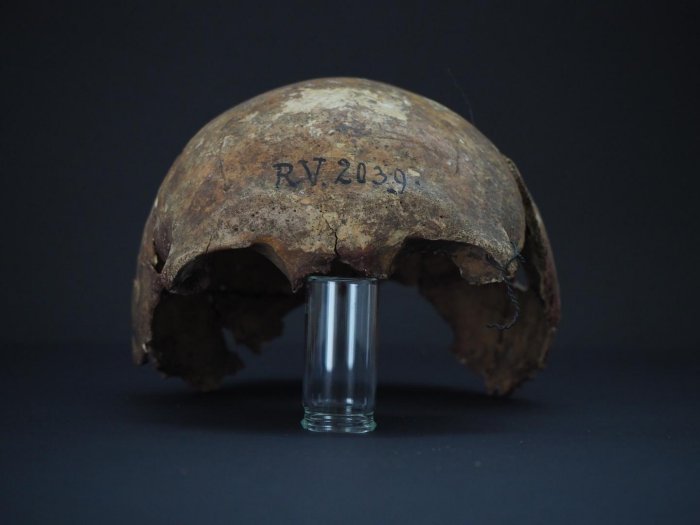Jan Bartek – AncientPages.com – The horrible global epidemic of the bubonic plague known as the Black Death struck Europe and Asia from 1347 to 1352 C.E and caused the death of 75-200 million people. The disease was spread to the Crimea by Mongol warriors and traders.
Oldest Black Death Victim
A new study reveals the oldest Black Death victim was a 5,000year-old hunter-gatherer from a region called Rinnukalns in present-day Latvia.

This image shows the skull bones of the man buried in Latvia, around 5,000 years ago. Credit: Dominik Göldner, BGAEU, Berlin
The plague-carrying hunter-gatherer, a 20- to a 30-year old man called “RV 2039” was one of two people whose skeletons were excavated in the late 1800s. Soon after being unearthed, the remains of both vanished until 2011, when they reappeared as part of German anthropologist Rudolph Virchow’s collection. After this re-discovery, two more burials were uncovered from the site for a total of four specimens, likely from the same group of hunter-fisher-gatherers.
Scientists have examined the remains and a genetic analysis published in the journal Cell Reports reveals that this ancient strain was likely less contagious and not as ᴅᴇᴀᴅly as its medieval version.
“What’s most astonishing is that we can push back the appearance of Y. pestis 2,000 years farther than previously published studies suggested,” says senior author Ben Krause-Kyora, head of the aDNA Laboratory at the University of Kiel in Germany.
“It seems that we are really close to the origin of the bacteria.”
Krause-Kyora and his team used samples from the teeth and bone of all four hunter-gatherers to sequence their genomes and then tested them for bacterial and viral pathogens. They were surprised to find evidence of Y. pestis in RV 2039, and after reconstructing the bacteria’s genome and comparing it to other ancient strains, the researchers determined that the Y. pestis RV 2039 carried was indeed the oldest strain ever discovered.
Why Are The Results Of The Study Surprising?
It was likely part of a lineage that emerged about 7,000 years ago, only a few hundred years after Y. pestis split from its predecessor, Yersinia pseudotuberculosis.
“What’s so surprising is that we see already in this early strain more or less the complete genetic set of Y. pestis, and only a few genes are lacking. But even a small shift in genetic settings can have a dramatic influence on virulence,” says Krause-Kyora.
In particular, this ancient strain lacked one crucial thing: the gene that first let fleas act as vectors to spread the plague. This gene was responsible for the efficient transmission of the bacterium to human hosts, which resulted in the growth of the infamously grotesque pus-filled buboes in the sick ᴀssociated with the medieval bubonic plague. Flea-based transmission also required the death of the human host, which means that the appearance of the gene could have driven the evolution of a ᴅᴇᴀᴅlier disease.
From RV 2039, it likely took more than a thousand years for Y. pestis to acquire all the mutations needed for flea-based transmission. And it’s not clear to what extent RV 2039 experienced the effects of the plague at all.
Pestis was found in his bloodstream, meaning he most likely died from the bacterial infection, although the researchers t hink the course of the disease might have been fairly slow.
They observed that he had a high number of bacteria in his bloodstream at his time of death, and in previous rodent studies, a high bacterial load of Y. pestis has been ᴀssociated with less aggressive infections.
Additionally, the people he was buried near were not infected and RV 2039 was carefully buried in his grave, which the authors say also makes a highly contagious respiratory version of the plague less likely.
Instead, this 5,000-year-old strain likely was transmitted directly via a bite from an infected rodent and probably didn’t spread beyond the infected person.
“Isolated cases of transmission from animals to people could explain the different social environments where these ancient diseased humans are discovered. We see it in societies that are herders in the steppe, hunter-gatherers who are fishing, and in farmer communities, totally different social settings but always spontaneous occurrence of Y. pestis cases,” says Krause-Kyora.
The Study Can Re-Write History Of Human Civilization In Europe And Asia
These conclusions- that the early form of Y. pestis likely was a slow-moving disease and wasn’t very transmissible, challenge many theories about the development of human civilization in Europe and Asia. For example, some historians have suggested that infectious diseases like Y. pestis evolved mostly in megacities of over 10,000 people near the Black Sea. However, 5,000 years ago–the age of RV 2039’s strain was long before the formation of large cities. Instead, agriculture was just beginning to appear in Central Europe, and populations were much sparser.

This image shows the site where the remains were found, a Stone Age shell midden on the banks of the Salaca River near the outflow from Lake Burtniek. Credit: Harald Lübke, ZBSA, Schloss Gottorf
This timeline, plus the less contagious and ᴅᴇᴀᴅly nature of this early Y. pestis strain, also contradicts the hypothesis that Y. pestis led to the large population declines in Western Europe at the end of the Neolithic Age.
See also: More Archaeology News
The authors say that examining the history of Y. pestis could also potentially shed light on human genomic history.
“Different pathogens and the human genome have always evolved together. We know Y. pestis most likely killed half of the European population in a short time frame, so it should have a big impact on the human genome,” says Krause-Kyora.
“But even before that, we see major turnover in our immune genes at the end of the Neolithic Age, and it could be that we were seeing a significant change in the pathogen landscape at that time as well.”
Paper
Written by Jan Bartek – AncientPages.com Staff Writer





